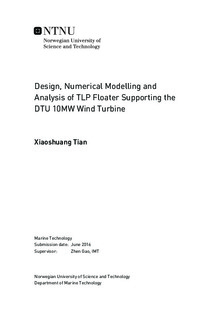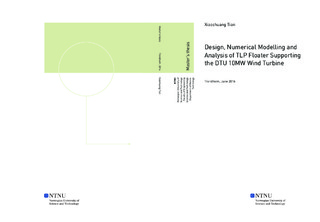| dc.description.abstract | The application of big-size wind turbine is constrained to land-base and shallow water nowadays. It is still challenging to build big-size offshore wind turbines in deep water. But challenge means opportunity. This thesis aims to examine a state-of-art TLP floater initial design for supporting the 10MW DTU reference wind turbine. The TLP floater consists of one single column, three spokes and three pretension tendons. In the meantime of this project, parallel works (Semi and Spar floaters) are designed. The obtained properties of these three concepts are compared.
Fundamentally different from other offshore structures, the TLPWT employs a tension mooring system instead of a catenary mooring system. The pretension per line is 28064kN and the yield tendon axial force is 1.8*10^5kN. Due to the stiffed tendons, the TLPWT has small response motions. Therefore, the tendon tensions are almost constant even in 50-year extreme conditions. Additionally, the maximum tension1 and minimum tension3 are examined by ULS, which results show that the TLPWT tendons have no possibility of slacking or exceeding yields tension. On the other hand, the response motions of the SemiWT and SparWT are relatively larger. The SparWT can experience maximum surge motion up to 25m and SemiWT can experience maximum pitch motion 16 deg at wind speed 11.4m/s.
The hydrodynamic behaviours of the TLPWT are assessed in details by performing a wave-only frequency-domain analysis in head sea. The added mass and damping coefficients present strong wave-frequency dependence. The viscous damping effect is of importance in the surge motion of the TLPWT in long waves. In order to compute correct second-order results within the element number limit, a mesh convergence study is performed regarding to the mesh size and radius of the second-order free surface model. Mesh case 3 is selected after a series of comparisons. As the second-order forces are small, their most important contribution is in the vicinity of resonance. For instance, the resonance of heave QTF coincides with the pitch/bending natural frequency.
The natural periods of the TLPWT are 45.23s, 0.55s, 0.60s and 20.87s in surge/sway, heave, pitch/roll and yaw respectively. It is very soft in horizontal motions, but quite stiff in vertical motions due to stiffed tendon mooring system. On the contrary, the SemiWT and SparWT concept are soft in both horizontal and vertical planes. Furthermore, it should be noted that the flexibility of the tower has a significant contribution to the TLPWT pitch motion. The tower bending natural period is 3.49s.
The rated wind speed for the three concepts is 11.4m/s. The wind turbine controller plays a vital role during operation process to maximize the energy capture, and minimize the external loads and thus response motions. In critical weather conditions, the controller can pitch, feather or even shutdown the turbine. Consequently, the platform motions become less, but the rotor speed, generated torque and produced power still keep constant.
The TLPWT experiences wave frequency motions of the same order of magnitude as those of SemiWT and SparWT in horizontal plane. In the vertical plane, however, the TLPWT behaves like a fixed structure. In addition, the heave motion and pitch motion of the TLPWT are kinematically coupled with its surge motion. Usually the low-frequency TLPWT motions are primarily excited by wind, while its pitch motion, blade root bending moment, tower base bending moment and tensions are excited by incoming wave frequency. Nevertheless, in harsh weather, the turbine is shutdown and all the performances of the TLPWT are therefore dominated by wave frequency.
In summary, the global performance behaviour of the TLPWT is desirable for a structure this size. The tension-leg mooring system suppresses nearly all vertical motions. The horizontal motion is quite small even in extreme weather conditions and thus there is rare change representing in tensions. Furthermore, the tower base and blade root bending moment are also much smaller than the Semi and Spar wind turbine. This TLPWT concept features with wide weather window, great load capacity and high stability. It is definitely reliable for the application of offshore wind turbines in deep water. | |

